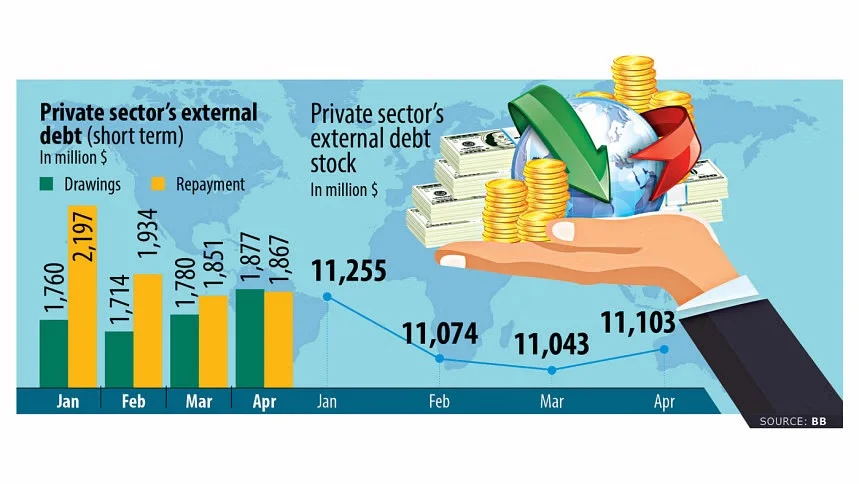Private sector’s foreign borrowing reverses downward trend
Share on:

Time Digital Report: The private sector's short-term foreign debt in Bangladesh made a turnaround for the first time in more than a year in April, handing a much-needed fillip to the foreign currency reserves.
In April, the private sector's short-term foreign debts reached $11.10 billion, an increase of $60 million from $11.04 billion in March, according to data from the Bangladesh Bank.
The private sector's foreign debt had been declining from the outset of 2023, and the trend continued into 2024.
The recent reversal came as the interest rate in the international markets began falling after central banks cut rates or held them steady following the easing of inflation. On the other hand, the lending rate in the domestic market has gone up sharply after the BB left the prices of loans in the hands of the market to step up its fight against stubbornly higher inflation.
Thus, local firms and businesses are again showing their interest in securing funds from international sources.
"The turnaround is good news, and if the momentum persists, the pressure on the reserves will ease and it may go up eventually," said Ahsan H Mansur, executive director of the Policy Research Institute of Bangladesh, a think-tank.
The recently introduced system for exchange rate management, known as crawling peg, and the market-based interest rate are widely credited for the improvement in the US dollar borrowing.
Before the recent change, banks used to set the rate in line with the instructions of the BB. Likewise, bank loans were capped at 9 percent between April 2020 and June last year before some flexibility was brought in from July through the scrapping of the ceiling. It was made fully market-oriented on May 8.
"If the central bank can properly implement the reform initiatives, the huge deficit in the financial account will also decline. Eventually, it will have a positive impact on the reserves," said Mansur, also a former official of the International Monetary Fund (IMF).
The reserves amounted to $19.21 billion on Wednesday as per the International Monetary Fund's calculation, less than half of the $41 billion seen in August 2021.
The unprecedented fall was one of the key factors for the deeper hole in the financial account, a component of a country's balance of payments that covers liabilities to non-residents and includes direct investments, portfolio investment, and reserve assets.
The deficit in the financial account stood at $9.26 billion in July-March of the outgoing fiscal year, BB data showed.
The reserves declined nearly $6 billion in January and May this year, with the private sector accounting for a $4.5 billion slip alone, said Mansur referring to a study.
Since the beginning of 2023, their borrowing decreased almost every month as the interest rate climbed in the international market. In 2022, the debt stood at $16.42 billion, and it fell to $11.79 billion.
Previously, the interest rate for foreign loans ranged from 1 percent to 2 percent. It has now jumped to 8-9 percent.
On the other hand, the interest rate in Bangladesh was 7 percent to 8 percent before June last year. Since the interest rate was freed, it has gone past 14 percent and could go up further.
Short-term private sector borrowing from foreign sources increased 5.45 percent to $1.88 billion in April from a month prior, BB data showed. This was way lower than seen in the past two years: it totalled $25.79 billion in 2023 and $37.25 billion in 2022.
Currently, central banks around the world are either cutting interest rates or have kept them on hold, a positive development for the countries that saw investors pulling their money out of Asian countries in late 2021.
Recently, the European Central Bank reduced interest rates, the first rate cut in nearly five years. The central banks of Canada, Switzerland, and Sweden have also decreased interest rates to reduce borrowing costs.
The US Federal Reserve is expected to cut its key interest rate in September and once more this year.

